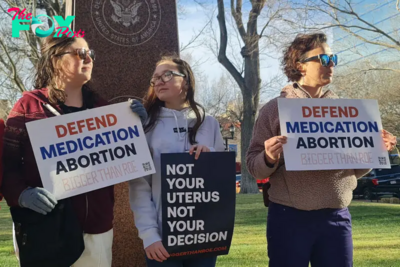Politics
US attempt to ‘revitalize’ Palestinian Authority risks making the PA less legitimate, more unpopular
Gaza is still very much in the midst of war, yet discussion is turning to “the day after” the coNFLict – and who will govern the war-ravaged territory.
The Biden administration has said that a full Israeli occupation of the Gaza Strip would be unacceptable. Instead, White House officials have discussed “revitalizing” the Palestinian Authority, or PA, the governing apparatus of parts of the West Bank, to take over in Gaza.
Seemingly as an initial step to enable this, the PA cabinet resigned on Feb. 26, 2024. This begins the process of overhauling the authority and setting up a “technocratic government” tasked with basic, short-term governance objectives, presumably in Gaza as well as the West Bank.
But analysts and researchers have questioned what role the PA could have, given that the body has struggled with a legitimacy crisis for well over a decade. And Israel has refused to countenance any PA involvement in post-coNFLict Gaza.
Moreover, PA officials are wary of entering Gaza “on the back of an Israeli tank,” in the words of resigning Palestinian Prime Minister Mohammad Shtayyeh.
As a scholar of Palestinian Politics, I believe any possible solution to the war in Gaza involving the PA will face significant challenges over its legitimacy, public support and ability to govern.
But why do Palestinians have such a negative assessment of the PA, and is that justified? To answer that, it is important to understand the shift within the Palestinian national movement since the creation of the PA in 1994 and the international community’s role in those transformations.
What is the Palestinian Authority?
The PA was created as a result of the Oslo Accords. The accords, a framework for negotiated peace that took place in the early 1990s, represented the first time in which the Palestine Liberation Organization, or PLO, and the state of Israel formally accepted mutual recognition.

The accords were intended to end the Israeli-Palestinian conflict and achieve some sort of two-state solution.
In anticipation of a future Palestinian state, the PA was established as a governing body. Elections were held, and the dominant party within the PLO, Fatah, also came to dominate the PA.
The goal was that by 1999, the Palestinians would have a state in the West Bank and Gaza. Negotiations would continue as the PA built out the institutions of the state, under the optimistic assumption that both could be arrived at concurrently.
But this shift from seeking liberation to state-building signaled compromises on the right of Palestinian refugees to return to the land they were expelled from during the creation of Israel.
Despite this, many Palestinians were supportive of having some pathway forward in which they might achieve self-determination and sovereignty.
The state-building project reoriented a great deal of energy and resources to the institutions of the Palestinian Authority and attempts by Palestinian leadership to achieve a viable Palestinian state.
The second intifada’s aftermath
When a state was not achieved by 1999, the second intifada, or uprising, broke out.
The Palestinian Authority struggled to maintain order and stability during the period, crucially because the Israeli military raided urban centers and attacked PA infrastructure. Analysts refer to the intifada as a moment of “infilaat amni,” or a collapse of order. It saw massive disruption to Palestinians and Israelis and many lives lost.
For the remnants of the PA and its American benefactors, the lesson learned from the second intifada was that such a collapse could never be allowed to happen again.
In the aftermath, the focus of the U.S. and the international community turned to restructuring the PA, expanding and “professionalizing” its security forces and ensuring that the PA would be a stalwart partner to Israel in maintaining security in the occupied territories.
But to an increasing number of Palestinians, this focus on security coordination and restructuring did not serve the needs of a people living under occupation. In fact, in the name of security, Palestinians saw themselves more and more repressed not just by the occupation forces but by their own government.
By the mid-2000s, after the intifada tapered off, it was clear the peace process was going nowhere; the Israeli government had become increasingly right wing, and Palestinian leadership seemed both less willing and less capable to represent its people’s interests.
In what amounted to a referendum on the status quo, Hamas beat Fatah and won in the 2006 parliamentary elections for the territories. But the results immediately led to instability and coNFLict between the two main Palestinian political factions: Fatah, which until then dominated the PA, and Hamas.
The international community also did not support the election results and empowered Fatah to remain in power.
This led to a split in governance between the West Bank and Gaza, with the PA losing control of Gaza entirely in the aftermath of infighting between the two parties.
In response, the international community – led by the U.S. – worked to bolster the PA once again.
The PA has not held elections since, with the president of the PA, Mahmoud Abbas, remaining in office well past his term limit.
Over the years, the PA has continued to play a security coordination role in the West Bank but is perceived as a burden by Palestinians and as having achieved little in improving their living conditions.
Rather, repression and fragmentation have only worsened within Palestinian society, even as the challenges imposed by the occupation have only amplified with a now 17-year-long blockade on Gaza and continued settlement building in the West Bank.
Many Palestinian today see the PA as little more than a “subcontractor of occupation in the West Bank.
Public opinion today
It is, then, perhaps unsurprising that the Palestinian Authority has faced an ongoing legitimacy crisis.
In a September 2023 poll by the Palestinian Center for Policy and Survey Research, 76% of Palestinians polled within both territories expressed dissatisfaction with the PA’s governance.
This lack of support for the PA does not necessarily signal support for Hamas either; in questions about possible parliamentary elections, Hamas garnered only 34% of the potential vote – second to Fatah.
These low approval trends are echoed in other polling. The Arab Barometer, for example, conducted polling merely days before Oct. 7 and found only 27% of respondents in Gaza selected Hamas as their preferred party. Comparatively, only 30% favored Fatah. Although subsequent polling in December shows a bump for Hamas, this is much more pronounced in the West Bank than in Gaza. And the majority of Palestinians still are unsupportive.
It is clear that most Palestinians are fed up with their political options. Furthermore, the PA has long abandoned attempting to reflect Palestinian public opinion – in no small part because of the international community and the role it wants the PA to play.
Revitalizing the PA, as the U.S. appears intent on doing, looks to be a Herculean task, given how low the body is held in the eyes of many Palestinians. Moreover, any outside attempt to empower unaccountable leadership – and ignore Palestinian public demands and input – risks repeating history. After all, this was precisely how the PA lost its legitimacy to begin with.
-

 Politics10h ago
Politics10h agoWhy Trump Actually Needs Mexico
-

 Politics10h ago
Politics10h agoMan Convicted of Killing Laken Riley Sentenced to Life in Prison Without Parole
-

 Politics16h ago
Politics16h agoHow the Biden Administration Protected Abortion Pill Access—and What Trump Could Do Next
-

 Politics16h ago
Politics16h agoWhy Trump’s Tariffs Could Raise Grocery Prices
-

 Politics1d ago
Politics1d agoThe First Trans Member of Congress Expected Pushback Like Mace’s Bathroom Rule
-

 Politics1d ago
Politics1d agoNew York Prosecutors Oppose Dismissing Trump’s Hush Money Conviction
-

 Politics1d ago
Politics1d agoWhite House Christmas Tree Is a Symbol of Resilience for Hurricane-Hit North Carolina Farms
-

 Politics2d ago
Politics2d agoHakeem Jeffries Wins Reelection as House Democratic Leader Despite Party’s Losses




















